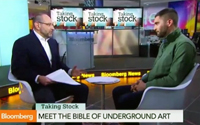.jpg)
Monkey Street Art Takes Aim at NIH Experiments
Street artist Dan Witz has painted baby monkeys across the Washington, D.C., area in support of PETA’s protest against NIH experiments
By Kelly Seegers
A street art campaign by artist Dan Witz has left paintings of imprisoned baby monkeys scattered throughout the Washington, D.C., area.
The artist says his work supports PETA’s campaign against experiments by the National Institute of Health (NIH) that separate infant monkeys from their mothers soon after birth. PETA Director of Laboratory Investigations Justin Goodman says the experiments are designed to scare the monkeys.
NIH has said the goal of the monkey studies is to learn the effects of social environments on infant development, according to a review released in December. Doctors acknowledged that the experiments place some stress on the baby monkeys, but the research center says the stress is necessary to learn how genetic and environmental factors affect the cognitive development of children. NIH did not comment directly about the street art, but released a statement affirming that it takes animal welfare seriously and have put protocols in place to ensure ethical treatment of the monkeys.
Witz began placing his paintings around Washington, D.C., on Thursday with the hope of raising awareness about the experiments, and now has pieces near NIH in Bethesda as well as in the District, near the Department of Health and Human Services, the Capitol and the National Mall.
Witz said that he paints on plastic in his studio and then glues the artwork to an object where it will blend in, such as signs, electrical boxes and doors.
A public information officer for the Montgomery County police department said Tuesday that the department had not received any reports about the placement of Witz’s artwork in the county, but the act would be considered vandalism.
Most of Witz’s paintings in the D.C. area feature monkeys staring out from behind the bars of what appears to be a ventilation grate. The artwork depicts photographs that PETA obtained from NIH through a Freedom of Information Act request, some of which can be found on their website. PETA did not ask Witz to create the street art or tell him where to place it, according to Goodman.
“The artworks are meant to blend into the environment and almost catch you by surprise,” Goodman said. “You think you are looking at a ‘Do Not Enter’ sign that has always been there and then after a moment you realize there are some monkeys…they give you some haunting images throughout the [District] to peak people’s interest and educate them about an issue that is relevant.”
Witz got his start painting hummingbirds around the streets of New York City in the late 1970s, before the term “street art” existed. He has since done work in dozens of cities around the U.S. and Europe, including in Rome, London, Berlin, Chicago, and San Francisco.
Witz previously highlighted a different PETA campaign with works in London. In London, he molded chicken feet and placed them in grates or public gardens around the city to raise awareness about the suffering of animals as a result of the meat industry.
“I think it is an interesting development for street art to be using it for activism,” Witz said Monday. “It is a kind of art form that exists in the public commons and I enjoy that the art form has evolved into having a social responsibility. I am really happy to be a part of that.”
Near each piece of art placed in the Washington, D.C., area, there is a hashtag that people can search on social media to find more information. Some of the hashtags that Witz is using for the monkey art are #actualvictims, #NIHmonkeytorture and #truthtopower.
Witz said he hopes to invoke shock in onlookers when they see his artwork on objects that they walk past every day. He hopes they will become curious about the treatment of the monkeys.
“We know about these things and we are like ‘Well, what can I do?’…because there are so many other things clamoring for your attention, but maybe if you have an encounter with a piece of art, maybe it will lodge it somewhere up in your conscience and you will pay attention to it more,” Witz said.

Street artist Dan Witz put up this work across from the Health and Human Services building in Washington, D.C.
A Witz work in Dupont Circle
http://www.bethesdamagazine.com/Bethesda-Beat/2015/Monkey-Street-Art-Takes-Aim-at-NIH-Experiments/




.JPG)
.JPG)


